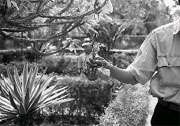The wealth of tradition
 what makes Vietnam particularly worthy from a biodiversity point of view is also its very rich base of traditional medicine. This means Vietnam has the potential to make a worthwhile contribution to the global food and health sectors. Says Nguyen Duc Tao of the Vietnam Pharmaceutical Corporation, which is trying to develop a market for medicinal plants, "In 1985, 1,863 plant species, equal to about 15 per cent of all plant species recorded in Vietnam, were known to be used for medicinal purposes. Since then, this number has gone up to 2,000 plant species, of which more than 70 per cent are found in the wild and mostly in the hill and mountain regions. Further research has revealed that some 450 species have clinical effects in the treatment of 60 different diseases. In addition, more than 40 species of animals are used for medicinal purposes, including bees, monkeys, geckos, snakes, bears and deer.'
what makes Vietnam particularly worthy from a biodiversity point of view is also its very rich base of traditional medicine. This means Vietnam has the potential to make a worthwhile contribution to the global food and health sectors. Says Nguyen Duc Tao of the Vietnam Pharmaceutical Corporation, which is trying to develop a market for medicinal plants, "In 1985, 1,863 plant species, equal to about 15 per cent of all plant species recorded in Vietnam, were known to be used for medicinal purposes. Since then, this number has gone up to 2,000 plant species, of which more than 70 per cent are found in the wild and mostly in the hill and mountain regions. Further research has revealed that some 450 species have clinical effects in the treatment of 60 different diseases. In addition, more than 40 species of animals are used for medicinal purposes, including bees, monkeys, geckos, snakes, bears and deer.'
Vietnam has taken a keen interest in traditional medicine since its independence in 1954. During the long years in which Vietnamese guerillas fought their French colonisers from their jungle hideouts, soldiers as well as civilians had to depend on traditional medicine as the only source of treatment and succour. Unlike other nations in the developing world, the Vietnamese leaders never forgot the importance of traditional medicine when they themselves became the rulers and framers of the nation's policies. The war with us that followed served to further strengthen Vietnam's dependence on traditional medicines. In the days of the conflict, Vietnam had little foreign exchange to buy modern drugs with, and the former Soviet Union (its mentor) was not of much help either. In order to reduce the dependence on modern drugs, Vietnam took recourse to herbs extensively and began using them in an organised way as frontline medicines. Only patients who could not be cured by these herbs, were prescribed antibiotics and other pharmaceuticals. The Hanoi-based Institute of Materia Medica has long researched and documented the use of herbs in Vietnam and the ministry of health, using this information, provides guidance to urban and rural health clinics to build up herbal gardens, so that they have ready access to medicines.
However, this system which worked efficiently until 1990, is now breaking down as a result of the changes wrought by the doi moi reform programme. During a visit to two rural clinics about 100 km from Hanoi, I found that while one clinic had no herbal garden of its own, the other had a herbal garden which was in a dilapidated state. "It all began to change in 1990,' said Nguyen Thi Bich, the nurse at Phuong Nam, one of the clinics. "Earlier, there were 11 people working in the clinic which serves 10,200 people; but now, there are only three. So there is nobody to take care of the herbal garden. Traditionally, the local community used to pay the staff with donations of rice and other commodities. But the doctors were not happy with this paltry remuneration. They demanded that the government pay them a decent wage
Related Content
- Production and promotion of organic and bio fertilisers with special focus on improving economic viability of gaushalas
- What drives the transition to modern energy cooking services? a systematic review of the evidence
- Benefit sharing in the mining sector in Africa
- Measuring resilience to climate change in Ethiopia
- Atlas of Ocean Wealth
- Drinking water salinity and infant mortality in coastal Bangladesh
